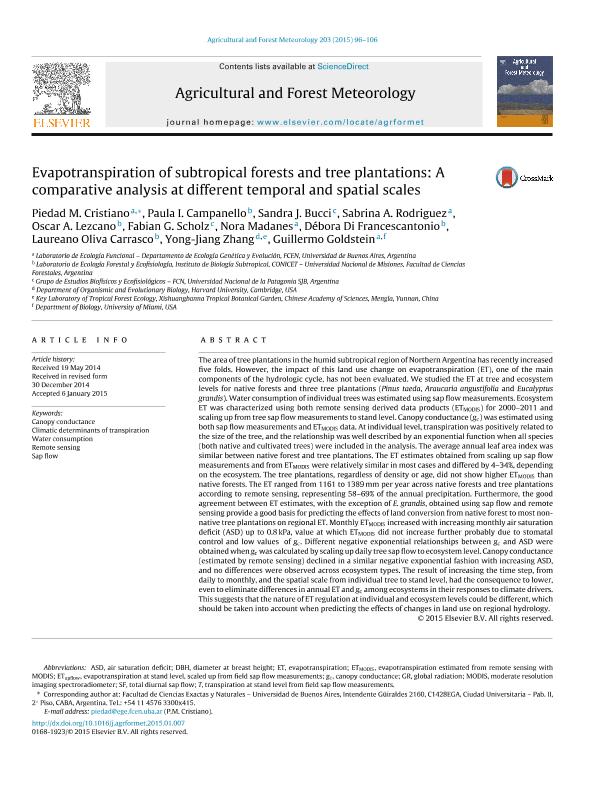Artículo
Evapotranspiration of subtropical forests and tree plantations: A comparative analysis at different temporal and spatial scales
Cristiano, Piedad María ; Campanello, Paula Inés
; Campanello, Paula Inés ; Bucci, Sandra Janet
; Bucci, Sandra Janet ; Rodríguez, Sabrina Andrea
; Rodríguez, Sabrina Andrea ; Lezcano, Oscar A.; Scholz, Fabian Gustavo
; Lezcano, Oscar A.; Scholz, Fabian Gustavo ; Madanes, Nora; Di Francescantonio, Débora
; Madanes, Nora; Di Francescantonio, Débora ; Oliva Carrasco, Laureano
; Oliva Carrasco, Laureano ; Zhang, Yong Jiang; Goldstein, Guillermo Hernan
; Zhang, Yong Jiang; Goldstein, Guillermo Hernan
 ; Campanello, Paula Inés
; Campanello, Paula Inés ; Bucci, Sandra Janet
; Bucci, Sandra Janet ; Rodríguez, Sabrina Andrea
; Rodríguez, Sabrina Andrea ; Lezcano, Oscar A.; Scholz, Fabian Gustavo
; Lezcano, Oscar A.; Scholz, Fabian Gustavo ; Madanes, Nora; Di Francescantonio, Débora
; Madanes, Nora; Di Francescantonio, Débora ; Oliva Carrasco, Laureano
; Oliva Carrasco, Laureano ; Zhang, Yong Jiang; Goldstein, Guillermo Hernan
; Zhang, Yong Jiang; Goldstein, Guillermo Hernan
Fecha de publicación:
06/04/2015
Editorial:
Elsevier Science
Revista:
Agricultural And Forest Meteorology
ISSN:
0168-1923
Idioma:
Inglés
Tipo de recurso:
Artículo publicado
Clasificación temática:
Resumen
The area of tree plantations in the humid subtropical region of Northern Argentina has recently increased five folds. However, the impact of this land use change on evapotranspiration (ET), one of the main components of the hydrologic cycle, has not been evaluated. We studied the ET at tree and ecosystem levels for native forests and three tree plantations (Pinus taeda, Araucaria angustifolia and Eucalyptus grandis). Water consumption of individual trees was estimated using sap flow measurements. Ecosystem ET was characterized using both remote sensing derived data products (ETMODIS) for 2000-2011 and scaling up from tree sap flow measurements to stand level. Canopy conductance (gc) was estimated using both sap flow measurements and ETMODIS data. At individual level, transpiration was positively related to the size of the tree, and the relationship was well described by an exponential function when all species (both native and cultivated trees) were included in the analysis. The average annual leaf area index was similar between native forest and tree plantations. The ET estimates obtained from scaling up sap flow measurements and from ETMODIS were relatively similar in most cases and differed by 4-34%, depending on the ecosystem. The tree plantations, regardless of density or age, did not show higher ETMODIS than native forests. The ET ranged from 1161 to 1389mm per year across native forests and tree plantations according to remote sensing, representing 58-69% of the annual precipitation. Furthermore, the good agreement between ET estimates, with the exception of E. grandis, obtained using sap flow and remote sensing provide a good basis for predicting the effects of land conversion from native forest to most non-native tree plantations on regional ET. Monthly ETMODIS increased with increasing monthly air saturation deficit (ASD) up to 0.8kPa, value at which ETMODIS did not increase further probably due to stomatal control and low values of gc. Different negative exponential relationships between gc and ASD were obtained when gc was calculated by scaling up daily tree sap flow to ecosystem level. Canopy conductance (estimated by remote sensing) declined in a similar negative exponential fashion with increasing ASD, and no differences were observed across ecosystem types. The result of increasing the time step, from daily to monthly, and the spatial scale from individual tree to stand level, had the consequence to lower, even to eliminate differences in annual ET and gc among ecosystems in their responses to climate drivers. This suggests that the nature of ET regulation at individual and ecosystem levels could be different, which should be taken into account when predicting the effects of changes in land use on regional hydrology.
Archivos asociados
Licencia
Identificadores
Colecciones
Articulos(CCT - NORDESTE)
Articulos de CTRO.CIENTIFICO TECNOL.CONICET - NORDESTE
Articulos de CTRO.CIENTIFICO TECNOL.CONICET - NORDESTE
Articulos(CCT-CENPAT)
Articulos de CTRO.CIENTIFICO TECNOL.CONICET - CENPAT
Articulos de CTRO.CIENTIFICO TECNOL.CONICET - CENPAT
Citación
Cristiano, Piedad María; Campanello, Paula Inés; Bucci, Sandra Janet; Rodríguez, Sabrina Andrea; Lezcano, Oscar A.; et al.; Evapotranspiration of subtropical forests and tree plantations: A comparative analysis at different temporal and spatial scales; Elsevier Science; Agricultural And Forest Meteorology; 203; 6-4-2015; 96-106
Compartir
Altmétricas



